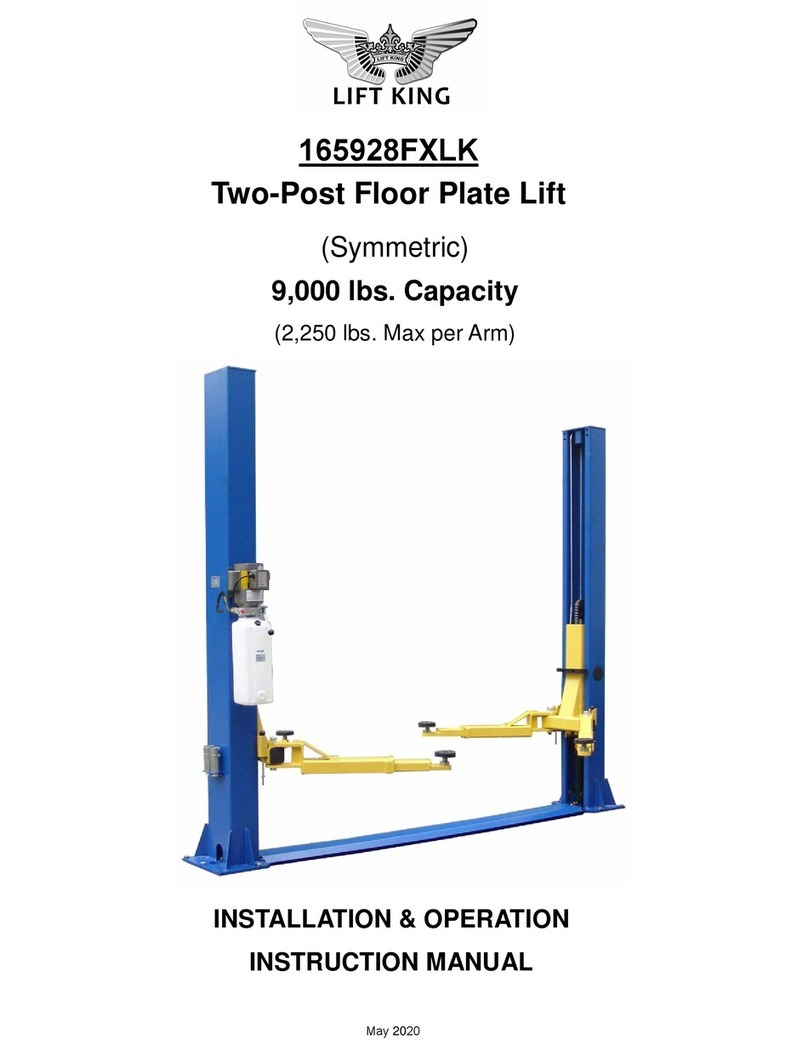
7
4. After drilling, remove dust thoroughly from each hole using compressed air and/or wire brush. Make
certain that the column remains aligned with the chalk line during this process.
5. Assemble the washers and nuts on the anchors then tap into each hole with a block of wood or
rubber hammer until the washer rests against the base plate. Be sure that if shimming is required
that enough threads are left exposed.
6. Using a level, check column plumb for every side (Fig. 9). If shimming is
required, use 3/4 “ washers or shim stock, placing shims as close as
possible to the hole locations. This will prevent bending the column
base plates.
7. With the shims and anchor bolts in place, tighten by securing the nut to
the base then turning 2-3 full turns clockwise. Or tighten anchor bolts to
150 ft-lbs. of torque. DO NOT use an impact wrench for this procedure. Fig. 9
STEP 5: (Mounting the OFFSIDE Column and the OVERHEAD BEAM)
1. Position the OFFSIDE column at the designated chalk locations.
2. Using a lift machine, raise the CROSS BEAM in position
on top of the columns. Bolt it to the columns using the
bolts, nuts and washers (Fig. 11).
3. Using a tape measure to measure the distance between the
opposite corners of the base plate on the columns. Equal
values will insure the lifting arms will be in square. Fig. 11
4. Secure OFFSIDE column to the floor following the same procedures as outlined in STEP 4.
STEP 6: (Mounting the POWER UNIT)
1. Attach the power unit to the MAIN COLUMN using bolts, nuts
and washers supplied (Fig. 12).
2. Remove the vent plug and fill the reservoir with hydraulic oil.
Make sure the funnel used to fill the power unit is clean.
Suggestion: Use AW 32, or 46 Non-Detergent Non-Foaming
Anti-Wear Hydraulic Oil. SAE-10 (Texaco HD46 or
equal). The unit will holds approximately ten Liters
of fluid.
Fig.12
STEP 7: (Routing the EQUALIZER CABLES)
1. Raise and lock each carriage on the first safety latch engagement. It is approximately 30” high.
2. Make sure that the safety locks on each column are fully engaged before attempting to route
equalizer cables.
3. Be sure each carriage is at the same height by measuring from the top of the base to the bottom of
the carriage. This difference should be within 1/4 ".
4. Rout the first cable. (See Fig 13-16) Screw the nut on the cable stud so that half thread pass through
the nut. Pull the other end of the cable and screw the nut on it also. Then tighten both nuts.
5. Repeat above for the second cable.
6. Adjust each equalizer cable to approximately 1/2 ” side-to-side play. So that they are equal tension.
































